Discover Love YOURself Natural Diamond Collection
What are the 4 C's?

The 4 C’s are the key factors used to evaluate and compare diamonds. They stand for Cut, Color, Clarity, and Carat weight — and understanding them can help you choose the perfect diamond for your style and budget.
Here’s a simple breakdown:
1. Cut
The sparkle factor.
The cut determines how well a diamond reflects light — which is what gives it brilliance and sparkle. It’s not about the shape (like round or oval), but how well the diamond has been cut and proportioned.
-
Graded from Excellent to Poor
- Excellent – Maximum sparkle and brilliance; ideal proportions and symmetry.
- Very Good – Nearly as brilliant as Excellent; minor differences in proportions or polish.
- Good – Still sparkly but with noticeable loss of light return.
- Fair – Duller appearance due to suboptimal proportions.
- Poor – Very little sparkle or fire; deep or shallow cuts reduce light performance.
- A well-cut diamond will shine brighter, even if it’s smaller
Tip: Cut is the most important C when it comes to beauty.
All our diamonds are:
| Very Good (VG) |
(JVC/GIA/AGS) |
Diamond reflects most light well; minor flaws in proportion, polish, or symmetry. | Great value; excellent brilliance, but slightly less than "Excellent" cut. |
| Very Good+ (VG+) | JVC | A top-tier Very Good diamond; better than average VG, possibly close to Excellent. | Indicates a better-than-typical VG cut, but not quite Excellent. Used for sales differentiation. |
2. Color
The less, the better.
Diamond color is graded on a scale from D (colorless) to Z (light yellow or brown). The less color, the more valuable the diamond (especially in white diamonds).
-
D–F: Colorless
-
G–J: Near Colorless (a great value!)
-
K–Z: Noticeable warmth
Tip: Slight color can be hidden with a yellow or rose gold setting.
3. Clarity
The tiny details inside.
Clarity refers to the natural imperfections (inclusions or blemishes) in or on the diamond. Most are microscopic and don’t affect beauty — but fewer inclusions = rarer = more valuable.
-
Graded from FL (Flawless) to I (Included)
-
Common grades: VS1–VS2 (Very Slight), SI1–SI2 (Slightly Included)
Tip: You can save by choosing a lower clarity that still looks clean to the eye (called “eye-clean”).
4. Carat Weight
The size — but not the whole story.
Carat measures the weight of a diamond, not its actual size. A higher carat means a bigger diamond, but two diamonds of the same carat can look different depending on their cut and shape.
-
1 carat = 200 milligrams
-
Popular sizes: 0.50ct, 1.00ct, 1.50ct, etc.
Tip: A slightly smaller carat (like 0.90 instead of 1.00) can save money without a big visual difference.
Final Thought
The perfect diamond isn’t about maxing out all 4 Cs — it’s about balancing them to suit your taste and budget.
At Tivani, we’ll help you find the right combination that gives you the most sparkle for your spend — whether it’s for an engagement, anniversary, or just because you deserve it.
Explore our diamonds → All Products
